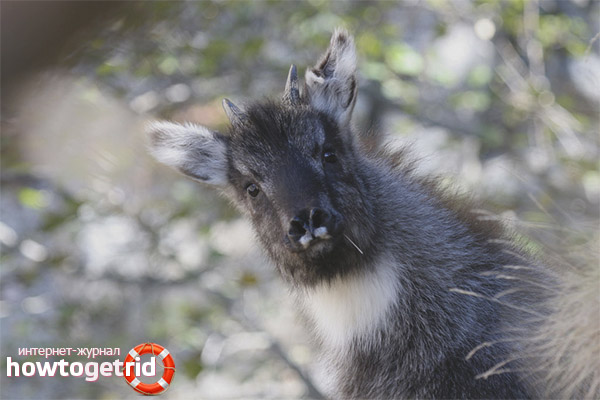The content of the article
Under the throat is meant a medium-sized animal, which in its external characteristics is somewhat similar to an ordinary domesticated goat. Only sizes, habits and some other features vary. If we summarize the presented individual, it resembles a goat crossed with an antelope. Distinctive features are the horns and tail. But let's not get ahead of ourselves, we will study the most important aspects in order of priority.
Description
- Gorals do not differ too much from domesticated goats. The body extends up to 100 cm in length. The weight category ranges from 35-40 kg. In individuals of this breed group, lush and coarse fur, it is elongated, in summer it becomes rare. The color of the mountain can be whitish, brown-red and grayish.
- A distinctive characteristic can be considered thick and massive limbs, which are covered with elongated wool, like the rest of the body. According to dimensional features, the eyes are not too large, directed in different directions. Ears extend up to 13 cm.
- Horns in the format of an arc, they are pigmented in a dark brown or black tone. In the upper part they are pointed, becoming like a cone. The hooves are small, allowing you to deftly move around rocks and other unstable surfaces. Animals feel all the bulges with their hooves, therefore they use their limbs well and almost never fall.
- In terms of distribution, these individuals like the mountainous rocky terrain. They are found in China, Russia, Korea and Burma. Previously, most of the population was dispersed near Khabarovsk and Primorsky Krai. Today there are very few gorals there.
Lifestyle
- There are many varieties of these individuals, but their lifestyle is almost identical. Often animals gather in packs of 10-12 individuals. Some people prefer to live in couples and families, while others prefer to live in splendid isolation. Males are prone to nomadism, always in search of food and territory.
- Gorals do not like the sun, they hide in the shade. They are active in twilight hours or early in the morning. If the day turned cloudy, the animals go to seek food and crawl out of the shelter. When the sun is outside, individuals are very passive. After choosing a suitable place, the throat does not move, lies and snoozes.
- Many people claimed that they literally ran into representatives of the family, as they merged with the environment. Animals by nature love to travel. They are constantly moving, can not be in the same area for too long. Each season begins with a new home.
- In the summertime, most of the population is dispersed over numerous green lawns located in the upper zone. When the cold approaches, individuals descend. Some exhibit unprecedented climbing abilities, climbing on the highest cliffs. This is especially true when you need to escape from enemies and hide.
- Animals of old age prefer to gather in groups with seblike in their age category. They keep apart, not confused with the young representatives. Animals of female gender live next to offspring. Males leave more often to be alone. Over the course of the life cycle, gorrals can change their preferences several times. Either they live settled, then they wander every year.
- Unfortunately, the considered individuals are not able to defend themselves with their teeth. In addition, these animals have not too long horns so that they can be fully defended. During the attack, such individuals hiss loudly at their opponent. But such actions do not help them in any way.If possible, the gorals are simply carried away by jumping into the rocks.
- Represented animals also cannot run away from their pursuer for a long time. The individuals have not very long legs and a rather heavy body. But such physiological features do not prevent them from jumping up to 3 m in length. It is noteworthy that the mountains are especially vulnerable in the snow. Therefore, animals try to avoid a place with loose snow, the depth of which exceeds 30 cm.
- When compared with other similar relatives, these individuals practically do not show any aggression. If the animals are in a group, they will always warn each other with a hiss, in case of danger. When looking for food, if the male finds food, he will always call relatives to share a meal.
- In the wild, it is often possible to observe that one group of such individuals often intersects with another. It is noteworthy that the animals are completely loyal to each other and in no way show aggression. The only exception may be the mating season. At such a time, the males arrange fights among themselves. The winner goes to the female.
Nutrition
- As for the daily diet, the individuals in question can truly rejoice in the abundance of plant foods only in the warm season. In such a period, the gorals eat everything that they come across in the way. They like to chew on leaves of bushes, flowers of plants, herbs and various fruits. Animals eat everything they reach.
- As for the cold season, at this time, the diet of such animals becomes scarce. But even so, individuals do not starve. They can eat thin branches of bushes and trees without problems. Also included in the diet are young shoots. Only such food can please animals in the cold period.
Gorals are quite interesting representatives of the wildlife. They live enough in harsh climates. However, they do not like to eat needles. They can enjoy such food when there is no other way out. Otherwise, they can eat mushrooms and lichens. Otherwise, animal habitats are good because there is enough food in any season.
Video: Amur Goral (Naemorhedus caudatus)










Submit